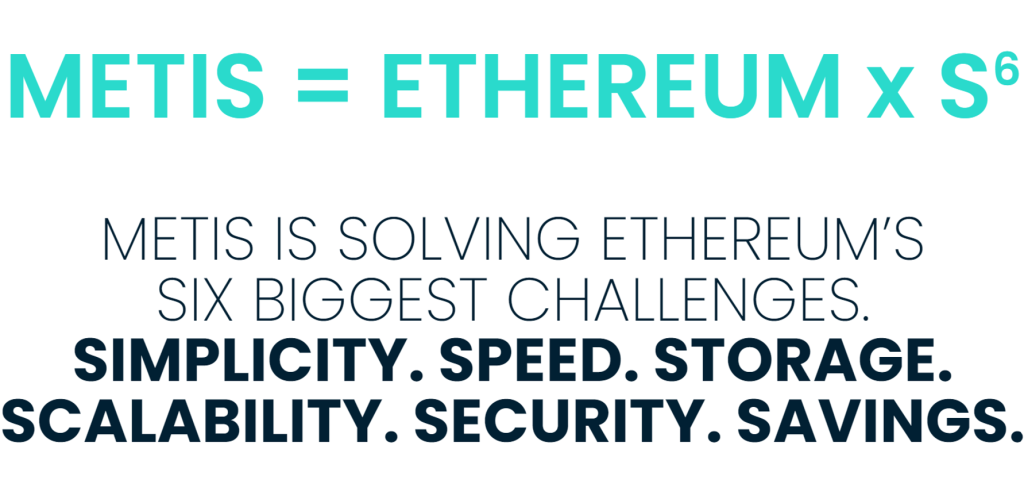The crypto market has been getting hammered lately and coins that mooned towards the end of 2021 are falling back to Earth.
This presents an opportune time to accumulate some of these gems, and for today’s article, I shall focus on $METIS.
What Is Metis?
Metis is an Ethereum Layer-2 scaling solution that was founded by Elena Sinelnikova in 2019.
*Fun fact: If you find her name familiar, that is because she also founded Crypto Chicks in 2017, which is a non-profit blockchain educational hub that helps women get started with blockchain technology. To further supplement her past experience and expertise in blockchain, she has assembled a strong team of competent leaders to bring Metis to greater heights. Among her team is Natalia Ameline, who is the mother of Vitalik Buterin (Ethereum’s co-founder).

Metis is a hard fork of Optimism and as shown in the picture above, it utilizes Optimistic Rollups.
What are rollups?
To understand Optimistic Rollups, we first need to understand rollups.
Rollups are smart contracts that serve as a ‘liaison’ between the main L1 chain (Ethereum) and the L2 (Metis).
Essentially, rollup solutions work by moving transaction computation off-chain (from L1 to L2). After transactions are executed, L2 will ‘roll up’ transaction data into a block. This block will then be sent back to the L1 chain for verification.
As such, the L1 chain is typically known as the consensus layer, whereas L2 is known as the execution layer.
How do Optimistic Rollups work?
In most Optimistic Rollup implementations, there are two main parties — aggregators on L2 and validators on L1. Specifically for Metis, L2 aggregators are called proposers and L1 validators are coined as verifiers.
After L2 executes the transaction, there will be a state transition to a new state. The transaction data that L2 ‘rolls up’ into a block is the state data representing the new state. Subsequently, the proposer will send the block that contains the updated state data to L1.
Also Read: Optimistic VS. Zero-Knowledge (ZK) Rollups Explained: What Are They And How Do They Work?
By default, L1 assumes transactions executed on L2 to be valid, hence the term ‘optimistic’.
But if a verifier notices an invalid transaction that could indicate fraud, the verifier will challenge the proposer. This ‘challenge’ process refers to the execution of a fraud proof to compute if fraud took place.
How do fraud proofs work?
Essentially, a fraud proof runs the transaction’s computation using the available state data. To decipher how and why this works, it is imperative to note that states are deterministic. E.g. Given two identical states, subjecting each state to the same transaction will result in 2 identical resultant states.
However, if fraud took place, the post-transaction state would differ. As such, the fraud proof algorithm takes the previous state and re-executes the transaction to obtain the correct state. If the correct state differs from the post-transaction state published by the proposer, then this serves as proof of fraud.

Fraud prevention
In aligning everyone’s interests, Metis incorporates a bonding system. When a proposer on L2 submits the block of state data to the L1 chain, it needs to post a bond (lock up $METIS).
If fraud is proven, proposers lose access to the bond, which goes to those who did the fraud proof instead. Thus, proposers get penalized for conducting fraud while verifiers are reimbursed for proving fraud.
Pros and cons
By implementing Optimistic Rollups, transactions are distributed more evenly, allowing Metis’ L2 to be highly scalable, fast, and low-cost as compared to Ethereum’s slow and expensive L1.
And with Ethereum as its L1, Metis’ level of security and decentralization is equivalent to Ethereum’s, and is much higher than that of alternative L1s such as Solana, Fantom, or Harmony.
As such, Metis can be viewed as the best of both worlds!

However, a downside to using Optimistic Rollups is that a period of time needs to be allocated for potential fraud challenges. As such, withdrawals can be delayed, and currently, it takes a week to bridge funds from Metis (and other L2s) back to Ethereum!
Sometimes, a fraud proof may also not be submitted even in the presence of fraud, thus resulting in an invalid state.
To minimise this issue, Metis employs a multi-party fraud detection system, which provides an additional layer of security.
This system, AKA the Metis Ranger System, introduces a unique role: L2 Ranger.
L2 Rangers are assigned a range of blocks that they are able to sample. They will then audit the corresponding transactions and must reach a consensus first before L1 verifiers can challenge transactions and initiate fraud proofs.
Intuitively, this second layer of security checks will help to improve the overall security of the chain. But the more important implication is that this renders the transaction finalisation process to be more efficient, allowing the withdrawal time to be cut down from a week to hours or even minutes!
Of course, this is just a theoretical estimate and only time will tell if this system is indeed efficient.
Conclusion
Now that we have gotten the technical features of Metis out of the way, my next article will focus on Metis’ business model.
Featured Image Credit: Grow via Medium
Also Read: All You Need To Know About Hedera $HBAR: Is It The Most Undervalued Token In 2022?



































